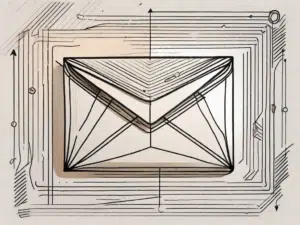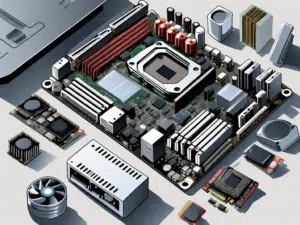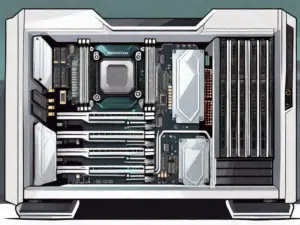USB, short for Universal Serial Bus, is a widely used technology that enables connection and communication between devices. It offers a convenient and standardized method for the Data transmission, powering and charging devices. In this comprehensive guide, we will look at the different aspects of USB and its potential applications. From understanding key terms to exploring the versatility of USB image files, we will demystify the technical terms and demonstrate the immense importance of USB in our modern world.
Put your knowledge to the test
Before we dive into the intricacies of USB, let's put your technical knowledge to the test. Take this quiz to test your knowledge of USB and related concepts:
A quiz to test your technical knowledge
- What does USB stand for?
- How many pins does a standard USB port have?
- What is commonly referred to as USB 3.0 designated?
- Can USB be used to charge devices?
- What advantages does USB have over other connection types?
Now that you've tested your knowledge, let's unravel the power of technology in our lives.
USB, short for Universal Serial Bus, is a widely used technology that has revolutionized the way we connect and interact with various devices. It has become an integral part of our everyday lives and allows us to transfer data, charge devices and connect peripherals easily.
When it comes to the number of pins in a standard USB connector, the answer is four. These pins serve various purposes including data transfer, power, and grounding. The design of the USB connector ensures a reliable and secure connection between devices and enables seamless communication.
USB 3.0, also known as SuperSpeed USB, is the third major revision of the USB standard. It offers significant improvements over its predecessors, including faster data transfer speeds, improved power capabilities and expanded backwards compatibility. With USB 3.0, users can enjoy lightning-fast file transfers and charge their devices more efficiently.
One of USB's most convenient features is its ability to charge devices. USB ports are typically found on computers, laptops, and wall chargers, so Smartphones, tablets and other devices can be easily charged. This versatility has made USB a popular choice for charging devices, eliminating the need for multiple chargers and cables.
So what makes USB different from other connection types? There are several advantages that make USB the first choice for many users. First, USB is a universal standard, meaning it is supported by a wide range of devices and operating systems. This compatibility ensures seamless connectivity across various platforms away.
In addition, USB offers the ability to hot swap, meaning the user can connect and disconnect devices without having to restart the computer. This convenience is particularly useful when using peripherals such as keyboards, mice and external hard drives.
Additionally, USB offers reliable and fast data transfer rates, making it ideal for transferring large files or streaming media. Whether you want to back up important documents or enjoy your favorite movies, USB ensures smooth and efficient data transfer.
Finally, USB has evolved over the years to keep up with the ever-increasing demands of technology. With each new release, USB offers enhanced features and capabilities that ensure users can stay connected and productive in today's fast-paced digital world.
Now that you have a deeper understanding of USB and its various aspects, you can better appreciate the impact it has on our daily lives. From charging our devices to transferring data, USB has become an essential technology that continues to shape the way we interact with our digital world.
Unleash the power of technology
In today's fast-paced world, technology plays a crucial role in shaping our lives. From smartphones to laptops and tablets to gaming consoles, technology has become an integral part of our everyday lives. USB as a versatile technology has contributed significantly to this networking.
How technology shapes our world
Advances in technology have revolutionized the way we live, work and communicate. From the convenience of online shopping to the transformative power of artificial intelligence, technology has made our lives more efficient and connected than ever before. USB is at the heart of this technological revolution, enabling seamless communication and data transfer between devices.
Understand the most important terms
Before we delve deeper into what USB can do, we need to familiarize ourselves with some important technical terms. Here are some important terms you should know:
Important technical terms you should know
- USB: Universal Serial Bus, a widely used technology for connecting and communicating devices.
- Plug and Play: The ability of a device or software to function automatically when connected to a computer or other device without the need for additional configuration.
- Data transfer rate: The speed at which data is transferred between devices is usually measured in megabytes per second (MB/s) or gigabits per second (Gbit/s).
- USB hub: A device that expands a single USB port into multiple ports, allowing multiple devices to be connected.
- USB Type-C: The latest USB connector standard that offers faster data transfer rates and reversible connector orientation.
Now that we have a better understanding of the key terms, let's explore the fascinating world of USB image files.
The magic of USB images
USB image files, also called ISO files, are digital representations of the contents of physical storage media such as CDs or DVDs. These files mimic the structure and data of the original media, allowing for easy reproduction and distribution.
Discover the versatility of USB image files
USB image files offer a variety of advantages in our digital world. They enable quick and easy installation of operating systems, software and games. They also serve as a reliable backup method for important files, ensuring that the data is preserved and can be easily restored.
USB image files allow you to carry your favorite operating systems, software suites and multimedia collections with you in a compact and portable way. The versatility and ease of use make USB image files an invaluable tool for tech enthusiasts, professionals and regular users alike.
Demystifying technical terms
Like any other field, technology has a whole range of terminology. Let's demystify some of the commonly used technical terms to ensure clear understanding:
A comprehensive guide to common technical terminology
- Byte: A digital unit of information consisting of 8 bits. It is often used to measure file sizes or data storage capacities.
- Bandwidth: The maximum data transfer rate of a network or communications channel, usually measured in bits per second (bps) or megabits per second (Mbps).
- Firewall: A security system that prevents unauthorized access to or from a private network, typically by analyzing and filtering network traffic.
- Cache: A small, fast memory area in which frequently used data is stored for quick retrieval. It helps improve overall system performance.
- Cloud computing: The use of a network of remote servers hosted on the Internet to store, manage and process data, rather than a local server or PC.
With these technical terms demystified, you can now confidently navigate the ever-evolving world of technology.
In summary, USB is a powerful technology that connects, supports and shapes our digital lives. We hope this comprehensive guide has provided valuable insights into the potential of USB - from understanding key terms to exploring the immense versatility of USB image files. Harness the power of USB and unlock a world of possibilities for your everyday tech endeavors.





